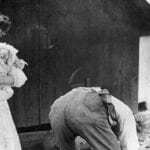 Our World
Our World  Our World
Our World  Pop Culture
Pop Culture 10 Incredible Female Comic Book Artists
 Crime
Crime 10 Terrifying Serial Killers from Centuries Ago
 Technology
Technology 10 Hilariously Over-Engineered Solutions to Simple Problems
 Miscellaneous
Miscellaneous 10 Ironic News Stories Straight out of an Alanis Morissette Song
 Politics
Politics 10 Lesser-Known Far-Right Groups of the 21st Century
 History
History Ten Revealing Facts about Daily Domestic Life in the Old West
 Weird Stuff
Weird Stuff 10 Everyday Products Surprisingly Made by Inmates
 Movies and TV
Movies and TV 10 Actors Dragged out of Retirement for One Key Role
 Creepy
Creepy 10 Lesser-Known Shapeshifter Legends from Around the World
 Our World
Our World 10 Science Facts That Will Change How You Look at the World
 Pop Culture
Pop Culture 10 Incredible Female Comic Book Artists
 Crime
Crime 10 Terrifying Serial Killers from Centuries Ago
Who's Behind Listverse?

Jamie Frater
Head Editor
Jamie founded Listverse due to an insatiable desire to share fascinating, obscure, and bizarre facts. He has been a guest speaker on numerous national radio and television stations and is a five time published author.
More About Us Technology
Technology 10 Hilariously Over-Engineered Solutions to Simple Problems
 Miscellaneous
Miscellaneous 10 Ironic News Stories Straight out of an Alanis Morissette Song
 Politics
Politics 10 Lesser-Known Far-Right Groups of the 21st Century
 History
History Ten Revealing Facts about Daily Domestic Life in the Old West
 Weird Stuff
Weird Stuff 10 Everyday Products Surprisingly Made by Inmates
 Movies and TV
Movies and TV 10 Actors Dragged out of Retirement for One Key Role
 Creepy
Creepy 10 Lesser-Known Shapeshifter Legends from Around the World
10 Places That Still Bear the Evidence of History
During times gone by, several events took place that formed history as we know and study it today. Some of these events left a mark on their surroundings that are still visible and even visited in modern times, as we continue to learn more about what life was like long ago.
This list reminds us that the past can still be visible in our present world. So let’s look at 10 places that still bear the evidence of history.
Related: 10 Strange Archaeological Discoveries
10 Dinosaur Dance Floor
Whether you believe in the existence of dinosaurs or not, there is heaps of evidence that giant animals roamed the earth in the past. Ancient Chinese writings speak of the discovery of “dragon” bones, which today are understood to be dinosaur bones. It is highly likely that ancient civilizations would have dug up fossils without knowing what they were looking at.
In 2008, dinosaur bones and fossils were no longer a novelty. However, scientists were still amazed at the discovery of an incredibly rare trail of footprints uncovered along the Arizona-Utah border. Imprinted into what is now known as the Vermilion Cliffs National Monument are over 1,000 footprints from different dinosaurs, including mothers and their babies. Researchers nicknamed the area the “dinosaur dance floor” because it was the type of place (a desert oasis, to be exact) that attracted crowds of these giant creatures.
Along with the footprints are rare dinosaur tail-drag marks, which also provide more evidence of wet intervals when the Southwest U.S. was covered with sand dunes that would have dwarfed the Sahara Desert.[1]
9 Black Tears
As Franklin D. Roosevelt stated, December 7, 1941, does indeed live in infamy. The surprise air attack by Japan on Pearl Harbor in Honolulu, Hawaii, changed the course of history and unceremoniously dumped America headfirst into WWII.
Today, at the Pearl Harbor Aviation Museum, visitors find themselves standing on an American World War II battlefield and looking at bullet holes and bomb craters in the hangars and surrounding tarmac.
But perhaps the bitterest reminder of that awful day is the USS Arizona Memorial, where the remains of 1,102 men still lie 12.2 meters (40 feet) below water, entombed in the ill-fated battleship. The forward deck of the ship was struck by a 798-kilogram (1,760-pound) bomb that triggered a massive explosion as it landed amid the Arizona’s own ammunition stores, which all exploded at the same time. The Arizona burned for almost three days after the attack, reaching temperatures three times hotter than the lava that spewed from the Kilauea volcano that erupted in 2018.
The USS Arizona still leaks oil that collects on the water’s surface. The puddles have been likened to black tears and are a horrific reminder of the devastating after-effects of war.[2]
8 Hominin Fossil Sites
Scientists believe that the universe was formed around 14 billion years ago and that our planet could be more than 4.6 billion years old. Furthermore, it is believed that life on Earth emerged around 3.8 billion years ago and that Africa is the birthplace of humankind.
When Johannesburg was just grasslands and rocks inhabited by saber-toothed cats, life was dangerous for young hominins. One of them found out first-hand just how dangerous when he was snatched up by a massive eagle and dropped into a series of subterranean limestone coves more than 2.5 million years ago.
In 1924, paleontologist Raymond Dart was a professor and lecturer at the University of Witwatersrand. On his way out the door to a wedding, he was handed two boxes containing fossils discovered at Taung. Inside, he discovered the skull of what, at first glance, appeared to be ape-like. But the more he studied the skull, the more he became convinced that the skull belonged to a hominin child that walked upright like a human. He named the fossil the “Taung Child” and touted the find as the missing link between apes and humans.
Other experts were not easily convinced. But two decades later, the pelvis of an adult was discovered in the Sterkfontein Caves near Taung. It was confirmed that this species, Australopithecus africanus, indeed walked upright. Since then, hundreds of hominin fossils have been uncovered in the area, leading to UNESCO declaring it a World Heritage site and referring to it as the “Cradle of Humankind.”
Fossils are still being found here. Thus many of the sites are closed to the public. But visitors can explore the history of the place in the Maropeng Visitor Center, the Taung Heritage Route that runs past the place where the Taung Child was extracted, and the Blue Pools.[3]
7 Earthquake of Biblical Proportions
The book of Amos describes a violent earthquake. The books of Zechariah and Ezekiel also mention an earthquake. Scholars agree that this earthquake would have taken place during the 8th century BC. Later, the Roman-Jewish historian Josephus wrote about an earthquake that had taken place during the time of King Uzziah.
Archaeologist Israel Finkelstein and his colleagues performed excavations and research at the ancient city of Megiddo in 2016 and found evidence of an earthquake from a similar period. In 2019, Finkelstein’s team reported that they had come across tilted and warped walls and pillars, fractured stones, dipping floors, liquefied sand, and more.
In 2021, an archaeological team from the Israel Antiquities Authority discovered a layer of destruction inside the City of David National Park. Within this layer, they found shattered lamps, utensils, jars, and bows, which were clearly destroyed as the building’s walls crumbled. Archaeologist Joe Uziel speculated that Jerusalem was not the epicenter of the quake but suffered considerable damage.
Another group of researchers found evidence of seismic activity in the area of the Dead Sea which showed that two major earthquakes had likely occurred during the eight century.[4]
6 The Plagues of Egypt
Earthquakes weren’t the only calamities to befall ancient biblical cities. According to the Bible, plagues struck Egypt in order to compel the Egyptians to let the Israelites go. Many historians refuse to believe that the plagues really happened, saying that they serve as allegorical exaggeration only. However, evidence exists that these plagues did occur in some form and took place in the ancient city of Pi-Rameses.
Archaeological evidence supports natural explanations for disasters that took place in Pi-Rameses, including a drought that changed the color of the Nile River. This drought is also believed to have forced frog populations to abandon the river before dying. The death of the frogs led to a massive increase in the number of insects which brought disease and, in turn, caused boils in humans.
The plagues, as described in the Bible, also include a thunderstorm of hail and fire, which experts believe refer to the eruption of Thera in 1628 BC. This eruption is considered to be one of the largest volcanic eruptions ever recorded, and ash deposits from this time have been discovered in the Nile region.[5]
5 A Horrific Time in History
In 1692 Colonial America, “witch fever” gripped the residents of Salem for seven months. More than 150 people were accused of and arrested for the practice of witchcraft, and twenty of them were executed. Five more died in prison. Unlike their European counterparts who were burned at the stake, those who were executed in Salem died by hanging (one was crushed under rocks).
It was a truly horrendous part of history, especially considering that most of the accusers were girls under age 20, and courts allowed residents to be put to death based on spectral evidence. This meant a witness could claim that an accused’s spirit inflicted harm upon them and “win the case.”
“Witch tests” were created to ensure that the accused would fail. For instance, if the accused verbally ordered the devil to depart from an afflicted victim, and they miraculously became “cured,” the accused simply proved that they were a witch. If they made a mistake reciting the Lord’s Prayer, they were a witch. If they touched their supposed victim and the person flinched, the accused would be proven to be a witch.
Today, more than 12 historic houses still stand in the Salem Village Historic District in Danvers, Massachusetts. The houses date from the witch trials era, and one in particular, the house of convicted “witch” Rebecca Nurse, can still be visited as a historical landmark. Nurse was hanged on July 19, 1692. Legend says that her son retrieved her corpse from the execution site and buried her in an unmarked grave in the Nurse family cemetery at the back of the house.[6]
4 Ancient Tsunami
A massive tsunami destroyed the Chilean coastline around 3800 years ago. This devastating event forced hunter-gatherers to move inland, where they remained for at least 1000 years.
Researchers who studied the tsunami spent many years in the Atacama desert under the leadership of Gabriel Easton, gathering evidence. The team discovered distinctive sediment left behind after a tsunami over a large area. They also uncovered a stone house at a site called Zapatero. The walls of the house had crumbled inward, which is indicative of being hit by a wave. Stones from another house were found scattered toward the sea, suggesting that the tsunami backwash pulled it along. The coastline in Chile lies on a subduction zone, which means one of the tectonic plates is being forced under another, making the area very susceptible to earthquakes.
Easton has surmised that the ancient earthquake that led to the tsunami would have been similar to the 1960 Valdivia earthquake, which was the largest earthquake ever recorded—a 9.5 magnitude quake.[7]
3 Badrulchau Monoliths
The Badrulchau Stone Monoliths are considered to be the largest and oldest archaeological site in Palau. There, 52 basalt stone monuments stand on the hill slopes of Babeldaob Island and are estimated to date back to AD 161. Some of the stones have faces carved into them.
Experts believe that the stones may have served as pillars for a Palauan meeting house which, according to legend, would have been constructed by the gods. If these monoliths are, in fact, the remains of a meeting house or bai, it would be the largest bai ever built. Most of the monoliths are about 1 meter (3 feet) wide and more than 2 meters (7 feet) high.
The legend also states that the stones were taken from Lukes, which lies between Peleliu and Angaur. The gods working on the foundation were done with their task first and started carrying their foundation pieces toward Ngarchelong. One of the gods, Medechii Belau, got his Loki on and turned a coconut husk into a crowing rooster. Believing that dawn was breaking, the gods turned away from their work (because they only worked in the dark). Those who were bringing more parts of the bai simply dropped them and left them where they fell.[8]
2 The World’s First Animal
Fatty molecules preserved in a rippled, flat fossil led researchers to proclaim that the fossil was the remnants of the oldest known animal in the history of Earth.
Dickinsonia, the animals responsible for these pancake-shaped fossils, were first discovered in the 1940s. They were some of the most common species found in the oceans around 558 million years ago but grew up to 1.4 meters (4.5 feet) in length which was unusual for any species at that time.
This puzzled experts because Dickinsonia lived millions of years before the Cambrian explosion. It also sparked debate on whether the species were primitive animals, single-celled organisms, or something different.
The findings of a study published in 2018 centered on the discovery of Ediacaran fossils, including Dickinsonia strewn on the shores of the White Sea, which had their organic matter and fats perfectly preserved. The Dickinsonia fossils contained 93% cholesterol, indicating that they were likely ancient animals living at least 17 million years before the Cambrian explosion. In other words, the first animals on Earth.[9]
1 Iron Age Temples
According to legend, Navan Fort, which lies near the city of Armagh in Northern Ireland, once hosted the kings of Ulster.
In 2020, it was reported that archaeologists discovered evidence of an enormous Iron Age temple complex, including residences at Navan Fort, which may have been occupied by the kings during the start of the medieval era.
Before this discovery, experts believed that the prehistoric hilltop enclosure’s inhabitants abandoned it around 95 BC. But with the identification of the new structures came the realization that Navan Fort’s history actually extended to the second millennium AD.
The temple complex is considered to be one of the largest and also most complex ever discovered in Europe. The temples have been studied with remote-sensing technology and a geophysical survey. These non-invasive techniques detected fluctuations in the soil’s properties, allowing archaeologists to probe the traces of the ancient structures beneath the surface.
The structures remain hidden underground and will only be excavated once the necessary funding has been acquired.[10]








